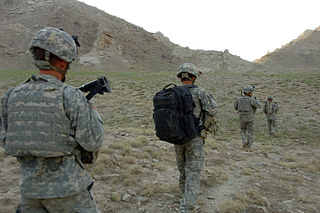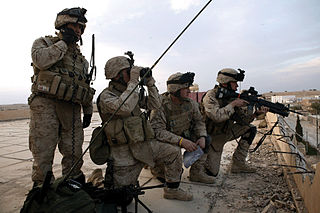
The Joint Tactical Information Distribution System (JTIDS) is an L band Distributed Time Division Multiple Access (DTDMA) network radio system used by the United States armed forces and their allies to support data communications needs, principally in the air and missile defense community. It produces a spread spectrum signal using Frequency-shift keying (FSK) and Phase-shift keying (PSK) to spread the radiated power over a wider spectrum (range of frequencies) than normal radio transmissions. This reduces susceptibility to noise, jamming, and interception. In JTIDS Time Division Multiple Access (TDMA) (similar to cell phone technology), each time interval (e.g., 1 second) is divided into time slots (e.g. 128 per second). Together, all 1536 time slots in a 12-second interval are called a "frame". Each time slot is "bursted" (transmitted) at several different carrier frequencies sequentially. Within each slot, the phase angle of the transmission burst is varied to provide PSK. Each type of data to be transmitted is assigned a slot or block of slots (channel) to manage information exchanges among user participation groups. In traditional TDMA, the slot frequencies remain fixed from second to second (frame to frame). In JTIDS TDMA, the slot frequencies and/or slot assignments for each channel do not remain fixed from frame to frame but are varied in a pseudo-random manner. The slot assignments, frequencies, and information are all encrypted to provide computer-to-computer connectivity in support of every type of military platform to include Air Force fighters and Navy submarines.

Single Channel Ground and Airborne Radio System (SINCGARS) is a very high frequency combat-net radio (CNR) used by U.S. and allied military forces. In the CNR network, the SINCGARS’ primary role is voice transmission between surface and airborne command and control assets.

The Stryker is a family of eight-wheeled armored fighting vehicles derived from the Canadian LAV III. Stryker vehicles are produced by General Dynamics Land Systems-Canada (GDLS-C) for the United States Army in a plant in London, Ontario. It has four-wheel drive (8×4) and can be switched to all-wheel drive (8×8).

The United States Army Special Operations Command (Airborne) (USASOC ( YOO-sə-sok)) is the command charged with overseeing the various special operations forces of the United States Army. Headquartered at Fort Liberty, North Carolina, it is the largest component of the United States Special Operations Command. It is an Army Service Component Command. Its mission is to organize, train, educate, man, equip, fund, administer, mobilize, deploy and sustain Army special operations forces to successfully conduct worldwide special operations.

Milstar is a constellation of military communications satellites in geosynchronous orbit, which are operated by the United States Space Force, and provide secure and jam-resistant worldwide communications to meet the requirements of the Armed Forces of the United States. Six spacecraft were launched between 1994 and 2003, of which only five were operational after launch; the third launch failed, both damaging the satellite and leaving it in an unusable orbit.

Long-range surveillance (LRS) teams were elite, specially-trained surveillance units of the United States Army employed for clandestine operation by Military Intelligence for gathering direct human intelligence information deep within enemy territory. Classic LRS employment is to infiltrate deep into enemy territory, construct hide and surveillance sites, and provide continuous surveillance/special reconnaissance of an intelligence target of key interest.

The People's Liberation Army Ground Force is the land-based service branch of the People's Liberation Army and the largest and oldest branch of the entire Chinese armed forces. The PLAGF can trace its lineage from 1927 as the Chinese Red Army; however, it was not officially established until 1948.

Air Naval Gunfire Liaison Company (ANGLICO) is an airborne fire support and liaison unit of the United States Marine Corps. The mission of ANGLICO is "To provide Marine Air-Ground Task Force (MAGTF) Commanders a liaison capability to plan, coordinate, and conduct terminal control of fires in support of joint, allied, and coalition forces. Per this mission statement, ANGLICOs are not designed to support U.S. Marine Corps maneuver elements. Instead, the doctrinal purpose of ANGLICO is to provide fire support and coordination in support of units adjacent to the MAGTF.

The United States Army Forces Command (FORSCOM) is the largest United States Army command. It provides expeditionary, regionally engaged, campaign-capable land forces to combatant commanders. Headquartered at Fort Liberty, North Carolina, FORSCOM consists of more than 750,000 active Army, U.S. Army Reserve, and Army National Guard soldiers. FORSCOM was created on 1 July 1973 from the former Continental Army Command (CONARC), who in turn supplanted Army Field Forces and Army Ground Forces.
Reconnaissance, surveillance, and target acquisition (RSTA) refers to a joint doctrine of reconnaissance, surveillance and target acquisition conducted by the United States Armed Forces. RSTA operations are designed to support military operations at a strategic, operational, or tactical level, either by dedicated RSTA forces or those which possess the capability.

United States Army Reconnaissance and Surveillance Leaders Course (RSLC) is a 29-day school designed on mastering reconnaissance fundamentals of officers and non-commissioned officers eligible for assignments to those units whose primary mission is to conduct reconnaissance and surveillance, target acquisition, and combat assessment operations. RSLC is taught by the 4th Ranger Training Battalion, Airborne and Ranger Training Brigade. The school is open to Soldiers, Marines, Sailors and Airmen to train them to expert levels in reconnaissance, surveillance, target acquisition, battle damage assessment, communications, planning, foreign vehicle identification, and other skills. The school was originally created to serve leaders from Long Range Surveillance Units (LRSU's), but now provides the specific reconnaissance training needed to ensure the effectiveness of small unit reconnaissance elements for the U.S. Army and joint force. Given the training focus and difficulty of the RSLC, the school is still commonly attended by operators from U.S. Army Special Forces, the 75th Ranger Regiment's Regimental Reconnaissance Company, U.S. Army Civil Affairs, Navy SEALs, and Marine reconnaissance units; today's students also come from more conventional infantry, Stryker and armored Brigade Combat Teams (BCT). Following the US Army decision to disband US Army LRS companies, the reconnaissance fundamentals taught in the course also provides U.S. military commanders the ability to preserve key LRS skills and abilities within the conventional force.

The 11th Corps Signal Brigade of the United States Army is an element of Army Forces Command. It is based at Fort Cavazos, Texas. The unit mascot is the Thunderbird, a hawk-like bird perched upon a globe shooting thunderbolts out of its eyes. Soldiers in this unit call themselves "The Thunderbirds."

The reorganization plan of the United States Army is a modernization (2015–2028) and reorganization (2006–2016) plan of the United States Army implemented (2006–2016) under the direction of Brigade Modernization Command. This effort formally began in 2006 when General Peter Schoomaker was given the support to move the Army from its Cold War divisional orientation to a full-spectrum capability with fully manned, equipped and trained brigades; this effort was completed by the end of 2016. It has been the most comprehensive reorganization since World War II and included modular combat brigades, support brigades, and command headquarters, as well as rebalancing the active and reserve components.

Advanced Extremely High Frequency (AEHF) is a constellation of communications satellites operated by the United States Space Force. They are used to relay secure communications for the United States Armed Forces, the British Armed Forces, the Canadian Armed Forces, the Netherlands Armed Forces and the Australian Defence Force. The system consists of six satellites in geostationary orbits. The final satellite was launched on 26 March 2020. AEHF is backward compatible with, and replaces, the older Milstar system and will operate at 44 GHz uplink and 20 GHz downlink. The AEHF system is a joint service communications system that provides survivable, global, secure, protected, and jam-resistant communications for high-priority military ground, sea and air assets.

Special reconnaissance (SR) is conducted by small units, such as a recon team, made up of highly trained military personnel, usually from special forces units and/or military intelligence organizations. Special reconnaissance teams operate behind enemy lines, avoiding direct combat and detection by the enemy. As a role, SR is distinct from commando operations, but both are often carried out by the same units. The SR role frequently includes covert direction of airstrikes and indirect fire, in areas deep behind enemy lines, placement of remotely monitored sensors, and preparations for other special forces. Like other special forces, SR units may also carry out direct action and unconventional warfare, including guerrilla operations.

In the United States (US) military, a beret flash is a shield-shaped embroidered cloth that is typically 2.25 in (5.72 cm) tall and 1.875 in (4.76 cm) wide with a semi–circular base that is attached to a stiffener backing of a military beret. These flashes—a British English word for a colorful cloth patch attached to military headgear—are worn over the left eye with the excess cloth of the beret shaped, folded, and pulled over the right ear giving it a distinctive appearance.
The British Armed Forces operates a wide range of communications and information systems. Some of these are specialised military systems, while others are procured off-the-shelf. They fall into three main categories: satellite ground terminals, terrestrial trunk communications systems, and combat net radio systems. Every part of the Army and the uses combat net radio, but only the Royal Corps of Signals and the Royal Air Force operates trunk systems and multi-channel satellite communications.

The 140th Military Intelligence Battalion of the United States Army Reserve was constituted on 16 July 1986, assigned to the 63rd Army Reserve Command, and activated with headquarters at the General George Smith Patton Jr. United States Army Reserve Center, located at 5340 Bandini Boulevard in Bell, California. The battalion inactivated in 1995.

PM WIN-T is a component of Program Executive Office Command, Control and Communications-Tactical in the United States Army. PM WIN-T has been absorbed into PM Tactical Networks as Product Manager for Mission Networks.

The United States armed forces classify reconnaissance missions as "close" or "short-range"; "distant" or "medium-range"; and "deep" or "long-range".


















